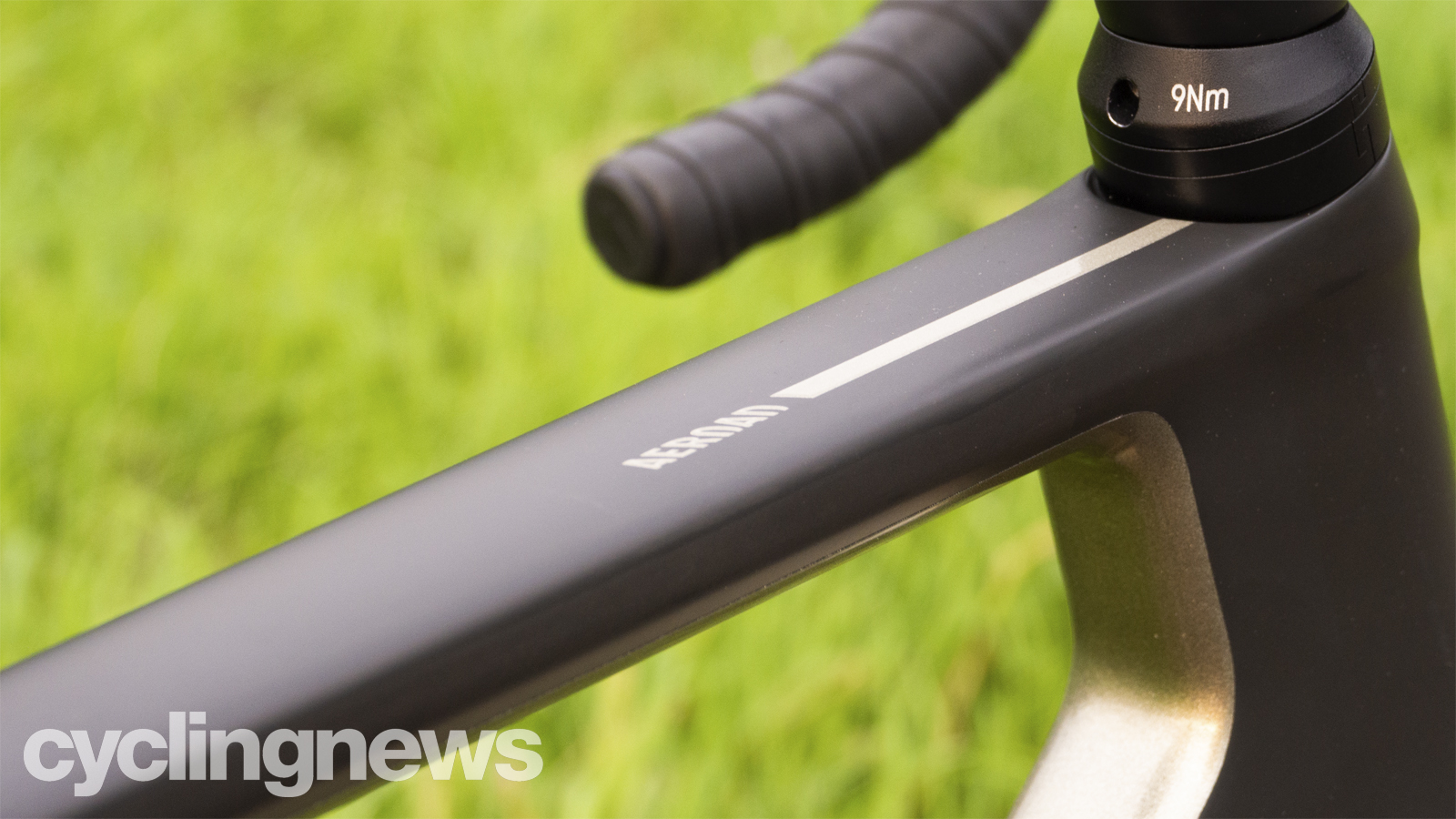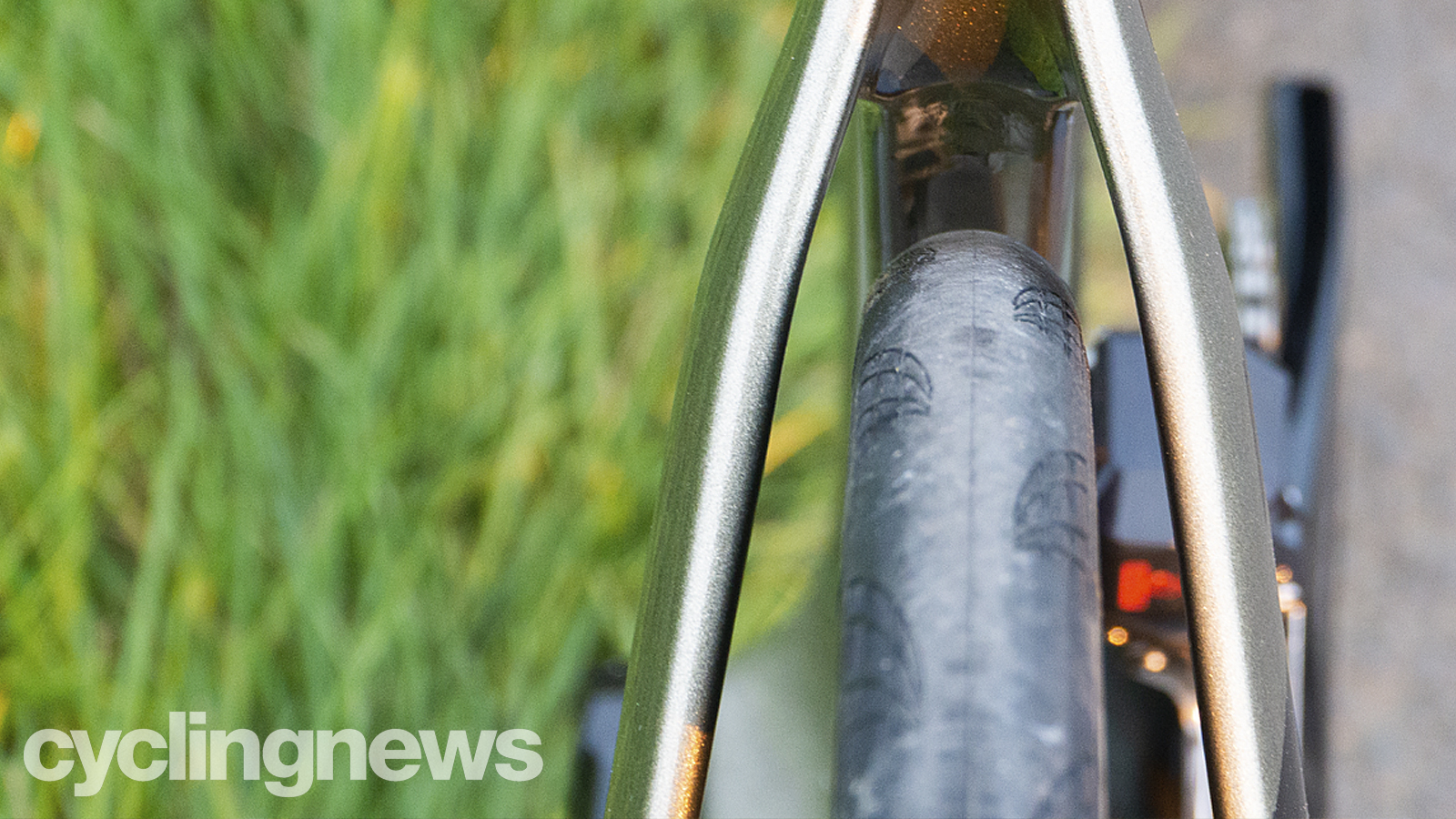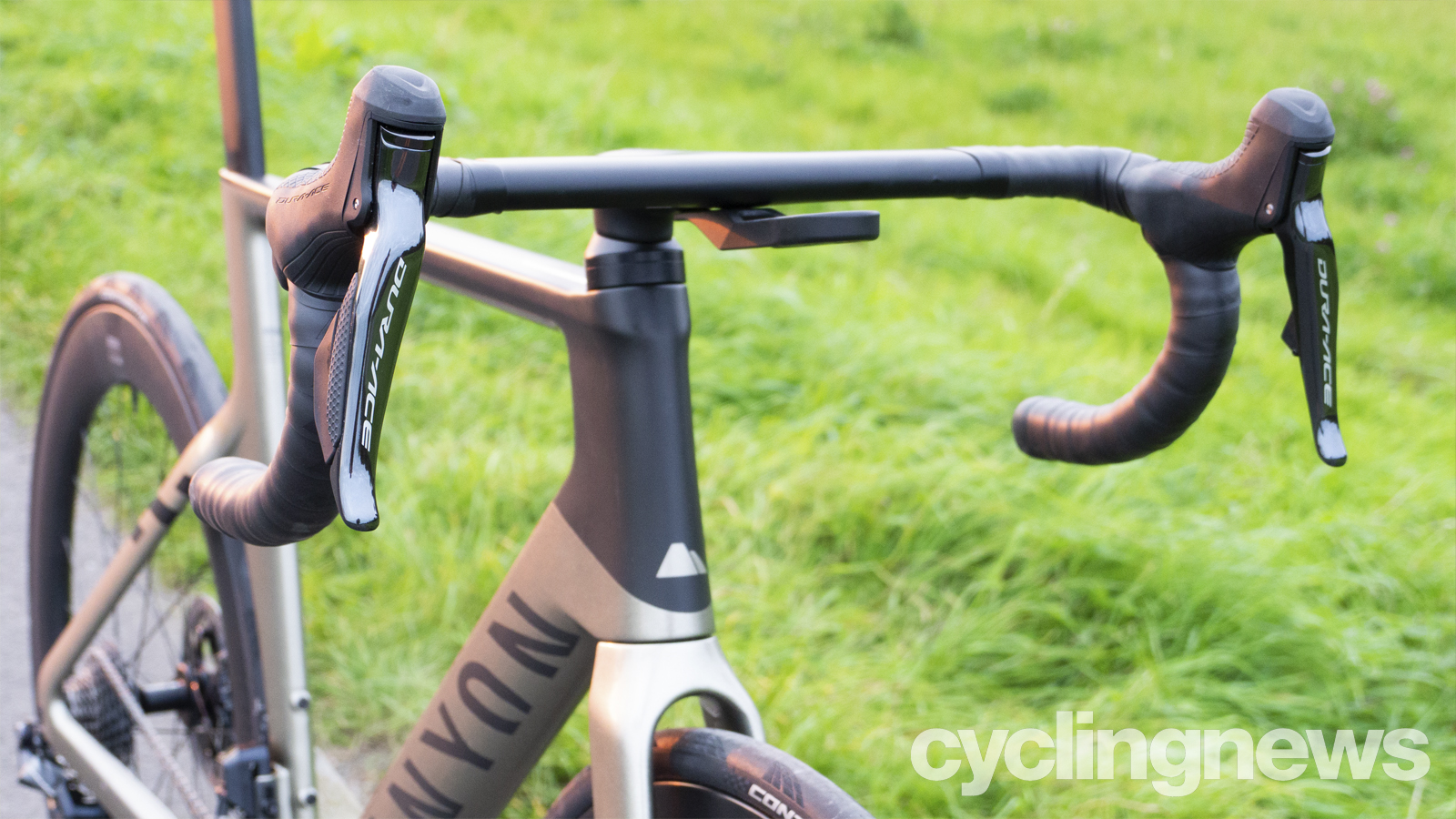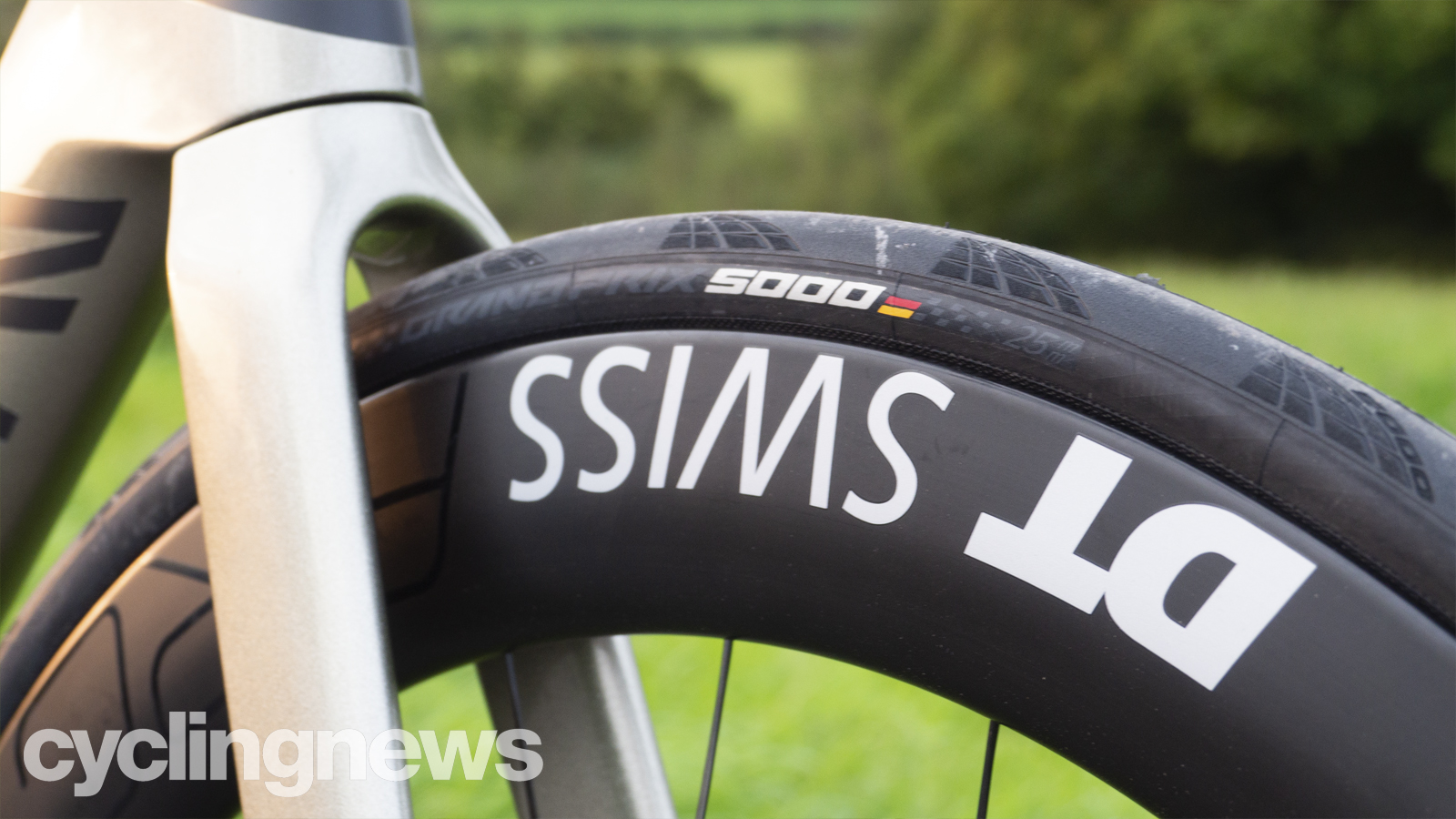Cyclingnews Verdict
The new Canyon Aeroad is lighter, faster, stiffer, yet just as comfortable as the original. It gets extra marks for creative engineering, and it's a fast and compliant bike to ride, but racers may want to wait a while
Pros
- +
Slightly relaxed geometry makes it suitable for more riders
- +
Genuinely comfortable ride
- +
Competitively low weight (7.3kg size L)
- +
Aero cockpit's cut-free stem height
- +
Width adjustable handlebars
Cons
- -
Restricted to Aeroad cockpit, of which six-degree rise option only available… for now
- -
Non-carbon-railed saddle seems out of keeping with otherwise high spec
- -
Specced with older DT Swiss ACR 1100 Dicut wheelset… for now
- -
Tubeless tyres not included
You can trust Cyclingnews
The 2021 Canyon Aeroad has finally been unveiled to the world, and with it came the usual raft of claimed improvements from the manufacturer. These include the 2020-appropriate claims of increased aerodynamics, reduced weight, and an integrated cockpit. However, it is upon closer inspection when the new Canyon Aeroad begins to stand out not only among the best aero road bikes, but among the best road bikes overall.
It has a bunch of nifty tricks up its sleeve that not only make the bike easier for Canyon to deliver in the first instance (important considering Canyon's direct-to-consumer nature), but also easier to live and travel with for the eventual owner.




The launch comes at a would-be-late point in the season for a bike launch; after the Tour de France and World Championships. But thanks to 2020's mismatched season, there is still plenty of racing for the peloton to sink their teeth into, and thus plenty of exposure opportunity for the bike, with the remainder of the Giro d'Italia, the Vuelta a España and the classics still to come.
The outgoing Aeroad has been around since 2014 and such was the success of the bike - both in testing and to Canyon's bottom line - the only change Canyon made in that time was the introduction of disc brakes. It's a bike that you've undoubtedly come across on the Sunday club ride or Tuesday night criterium and it's won everything from town sign sprints to that Amstel Gold. For this reason, the new Aeroad is possibly the most important bike that Canyon has launched in its lifetime, so it's perhaps unsurprising that the German firm has taken its time.
Canyon's aim was to make the bike better, and according to the German brand, it has engineered a frameset that's seven watts faster, 14 per cent stiffer, and 168 grams lighter than before, as well as simple to adjust, maintain, and ultimately live with. It also gets a more relaxed geometry meaning it should be more comfortable for the masses.
The result is a bike that positions itself as an aero all-rounder, up against the likes of the Specialized Tarmac SL7, the new Merida Reacto, and the 2021 Trek Madone.
Cyclingnews has managed to get hands-on with the new Aeroad CFR ahead of the launch, complete with Dura-Ace Di2 groupset and DT Swiss ARC 1100 wheels.
The test period was limited to a 10-day stretch, but in that time, the early impressions are of a bike that is composed, comfortable, yet fast and furious when necessary.
Our size large test bike weighs in at 7.3kg, so it won't challenge the thoroughbred lightweights in a race for the fewest grams - Canyon's Ultimate CFR will see to that instead. Rather like its predecessor, it remains a contender for our guide to the best aero road bikes, but with a few minor adjustments, it will comfortably meet the 6.8kg weight limit for those who find it actually matters - as proven by Valverde's choice to ride it for every stage of the 2020 Tour de France.
Ultimately, it's a race-ready aero bike that will appeal to a wide audience of racers, café cyclists and club riders alike.
Design and aesthetics

Our test bike comes in what Canyon calls 'tinted chrome' colour, but depending on the time of day, the position of the sun in the sky, and which side of the bed you got out of this morning, you'll see greens, golds, a bit of bronze, a touch of silver, and who knows what else. I'll be honest, in the dimly lit gloom of my garage, it looks a bit underwhelming, but get it out into the golden hour of an autumnal sunset and it does look rather pretty.

The tubes on which the paint is applied are undeniably Aeroad in their genetics. The seat tube still wraps around the rear wheel and the top tube still follows the same horizontal profile, but most of those tubes are considerably upsized in the pursuit of increased aerodynamic efficiency.
It would be a safe assumption that an increase in tube dimensions would equal an increase in weight, but our large test model's 7.3kg overall weight backs up Canyon's claimed 168g decrease. The ride quality and frame stiffness are other traits that can suffer with increased tube sizes or decreased weight, but on early impressions, this does not seem to be the case. Power transfer doesn't feel quite as sharp as some of the competition I've tested of late, but the difference is minute - it's still certainly no slouch out of the corners.


In addition to larger tubes, the fork legs and rear stays have been widened - another 2020-appropriate feature - meaning wider tyre clearances of 30mm, although that's within the ISO standards and could easily accommodate a few extra millimetres.
One of the major changes that Canyon has applied to the new Aeroad is a new geometry. Taking the aggressive position of the original, Canyon has increased the stack by 9mm and shortened the reach by 5mm to create a bike that more people are able to take advantage of.
| Model | Stack | Reach |
|---|---|---|
| Original Canyon Aeroad | 570 | 403 |
| New Canyon Aeroad | 580 | 401 |
| Scott Addict RC | 588 | 400 |
| Giant TCR Advanced SL | 581 | 402 |
| Specialized S-Works Tarmac | 581 | 405 |
| Trek Emonda SLR H1.5 | 581 | 396 |
| Row 6 - Cell 0 | Row 6 - Cell 1 | Row 6 - Cell 2 |
| Row 7 - Cell 0 | Row 7 - Cell 1 | Row 7 - Cell 2 |
| Row 8 - Cell 0 | Row 8 - Cell 1 | Row 8 - Cell 2 |
| Row 9 - Cell 0 | Row 9 - Cell 1 | Row 9 - Cell 2 |
For those of us who like it long and low, the proprietary cockpit's negative-six-degree angle will be a put-off, but Canyon's already got a slammed negative-17 stem on the bikes of its pro riders, and it'll be making available to the public a few months after launch.
Talking of cockpits, that brings us onto the real talking point of the new bike. The catchily named CP0018 Aerocockpit.
Quill stem
On face value, this system is a one-piece bar and stem combo like any other, but on further inspection, it's altogether different, and it's one of a few innovations that set the Aeroad apart from its competition.





With today's crop of bikes all aiming to remove cables from the wind to create a faster and cleaner-looking cockpit, the ways in which engineers have tackled the problem has differed from brand to brand. Specialized route the cables through the bars but beneath the stem in their two-piece front-end solution. One of the downfalls of a completely integrated one-piece system is that should a rider wish to trial a lowered position, the steerer needs to be cut first.
Rather than follow Specialized, Giant's and Scott's various systems of a plastic cover over the stem, Canyon decided to look to history and created a modern adaptation of the quill stem.
This system allows the stem to be risen and lowered by 15mm (in 5mm increments) without cutting. The benefit is that a rider can trial lower positions without cutting the steerer, and raise it again if necessary - something that will also help with the bike's resale value down the line. But the downside is that it commits the Aeroad to this cockpit, which at the time of launch at least, is only available in the aforementioned negative-six-degree angle.
While the raising and lowering of this stem will be rather simple for a skilled mechanic, it's still perhaps confusing to the rest of us, and as such, Canyon has provided a video walkthrough.


In the middle, an integrated out-front mount is provided with the necessary mounting accessories for all the best cycling computers, however, I think Canyon left the design of this component to the intern, as it angles up really awkwardly. A couple of angled shims would solve the issue, but Canyon, this one's due a redesign, please.
Foldable, adjustable handlebars
Canyon, not shy of a bonkers cockpit redesign (as we learned previously in our Canyon Grail review), then went a step further with the handlebar section of this new cockpit.

Because of the brand's direct-to-consumer approach, all of its bikes are shipped via courier and in most cases, are assembled at home without the help of a shop mechanic. Therefore, with the more complex assembly of integrated cockpit design, Canyon chose to split the handlebars at the tops so that bikes could be boxed safely and assembled easily.
The outer portion (drop, hood and a portion of the top) simply slides into the centre and is affixed using a couple of Torx bolts. In doing this, Canyon has also answered a frustration of many new bike owners by offering a choice of three widths. Meaning the change in bar width can be trialled, tested and reversed without removing handlebars or disconnecting cables.
Not only does this mean bikes are safer in their first journey, but it also makes for easier disassembly when packing your bike for travel.


Having adjusted the bars myself, I can confirm the process is straightforward, but it does require a Torx key and a torque wrench - I wouldn't want to risk under- or over-tightening such a crucial component bolt.

I would like to see deeper-contact Torx bolts though, the interface between tool and bolt is extremely shallow, and given Torx are prone to stripping, I would warn anyone adjusting it to take extreme care. The last thing you want is a bolt you can't tighten properly.
To retain a neat finish, the bar tape will need to be unwrapped to the shifters and rewrapped. Unfortunately upon unwrapping, the bar tape on our test model tore a little during the unwrap. I saved it from tearing in two with a little care and finesse, but given Canyon is inviting its owners to adjust it, I'm surprised that it hasn't fitted something that can handle being adjusted multiple times.
Having tested it, the cables on our test bike weren't cut long enough so I couldn't remove the right-hand section. However, this is just a test bike issue, as a bike delivered in this state would already have the outer portion removed for shipping. The other potential concern I have (although not something I experienced in my short test period) is that should a rider use the narrowest bar width, the cables could be too long and rattle in the tops. Though easily accessible and therefore probably solvable at-home.
On paper, this system could be considered heavy, prone to failure, or at least rather flexible to result in an inexact handling experience. On early impressions, it's not the case.
While original concerns led me to think such a crucial part of the bike might not want to be held in place by some small bolts, but with an inner- and outer-sleeve, it's likely to be more secure than a traditional stem and faceplate system, which relies on force to prevent slipping.
Specifications













The Canyon Aeroad range comprises eight models across three platforms. The top-tier CFR, the mid-level CF SLX, and the lower tier CF SL. Our test model here is the halo model CFR, with its new carbon layup. It's the Dura-Ace Di2 model, complete with DT-Swiss ARC 1100 wheels, the aforementioned CP0018 cockpit, and Shimano's Dura-Ace R9100-P power meter crankset which spins inside a BB86 bottom bracket.
Despite the recent announcement of a new pair of ARC 1100 wheels from DT Swiss, the Aeroad will ship with the older outgoing wheelset for the time being. A potential put-off for would-be owners looking to pull the purchase trigger on launch day.
The specced wheels feature DT-Swiss well-renowned 240 hub internals, complete with ceramic bearings. The rims are 62mm deep front and rear, yet crosswind stability was a non-issue.
The wheels are tubeless compatible, however, Canyon's choice of tyres is the non-tubeless versions of Continental's GP5000. They're widely considered as some of the best road tyres available, but they are tube-type only, so tubeless converts will have an extra outlay should they wish to ditch the tubes.
Canyon has also opted to run odd tyre sizes, with a 25mm front paired with a 28mm rear. On DT-Swiss' current ARC 1100 wheels (with their matching internal rim widths), this is visually noticeable, however when Canyon starts to spec the bike with the new wheels (which have a wider front internal rim), the visual difference will be reduced.
Crank length on our size large model is a commonly found 172.5mm, the stem length is an equivalent 110mm, and the middle section bar width is 410mm, although as mentioned, this can be widened or narrowed by 20mm.





The seatpost is a new addition - the SP0046, as Canyon calls it - is deeper in profile than the previous model, but to negate the increase in weight that the extra material would create, it narrows at the lower section which is hidden inside the frame. This is also said to aid comfort and while comfort is one of the surprisingly good elements of the new Aeroad, I'm not yet sure whether it's due to the seatpost, the 28c rear tyre, or the frame as a whole.
The seatpost is topped with a Selle Italia SLR Lite saddle, which without a carbon rail, seems a little out of keeping with the high-spec nature of the rest of the bike.
Riding experience: Composed but fast
As mentioned, my test period with the Canyon Aeroad was limited to just 10 days, so any early impressions are just that.
The way the new Aeroad rides is really composed and predictable, but it's far from boring. It doesn't feel quite as punchy as some of its competitors but it's still very much ready to race, and while I'm yet to put it through more than a couple of hours at a time, it feels comfortable enough for a big day on the pedals.
Early verdict
It's hard to form a complete verdict in such a short period of testing, but nonetheless, I feel the 2021 Canyon Aeroad will find favour with budget-conscious racers and cafe cyclists alike, thanks to its competitive weight, increased aerodynamics and comfortable ride.
The fact that you're getting already-superceded wheels is a bitter pill to swallow, though. The non-carbon saddle and non-tubeless tyres are minor bugbears, and the delay to the more aggressively positioned cockpit will put off some of the most slammed of riders.
Even with that in mind, those are small concerns for a bike that costs over £2000 less than its biggest rivals. At €7,499 / £7,699, there's no denying it's one of the best road bikes in terms of value for money.
Although, without wanting to spark the debate, there can be a lot of value attached to buying your bike from your local bike shop, especially should the bike go wrong down the line, and that's something you're giving up when choosing Canyon.
Logbook
- Test term: 10 days
- Rides: 3
- Mileage: 150km
- Punctures: 0
- Ride types: Easy spins, sustained efforts
Tech spec: Canyon Aeroad CFR
- Price: €7.499 / £7,699 / $7,599 / AU$11,749
- Frame: Aeroad CFR
- Size: L
- Weight: 7.3kg (actual, L, no pedals)
- Groupset: Shimano Dura-Ace Di2 disc
- Crankset: Shimano Dura-Ace R9100P
- Wheels: DT Swiss ARC 1400
- Brakes: Shimano Dura-Ace hydraulic
- Bar/stem: Canyon CP0018
- Seatpost: Canyon SP0046
- Saddle: Selle Italia SLR Lite

Josh is Associate Editor of Cyclingnews – leading our content on the best bikes, kit and the latest breaking tech stories from the pro peloton. He has been with us since the summer of 2019 and throughout that time he's covered everything from buyer's guides and deals to the latest tech news and reviews.
On the bike, Josh has been riding and racing for over 15 years. He started out racing cross country in his teens back when 26-inch wheels and triple chainsets were still mainstream, but he found favour in road racing in his early 20s, racing at a local and national level for Somerset-based Team Tor 2000. These days he rides indoors for convenience and fitness, and outdoors for fun on road, gravel, 'cross and cross-country bikes, the latter usually with his two dogs in tow.
